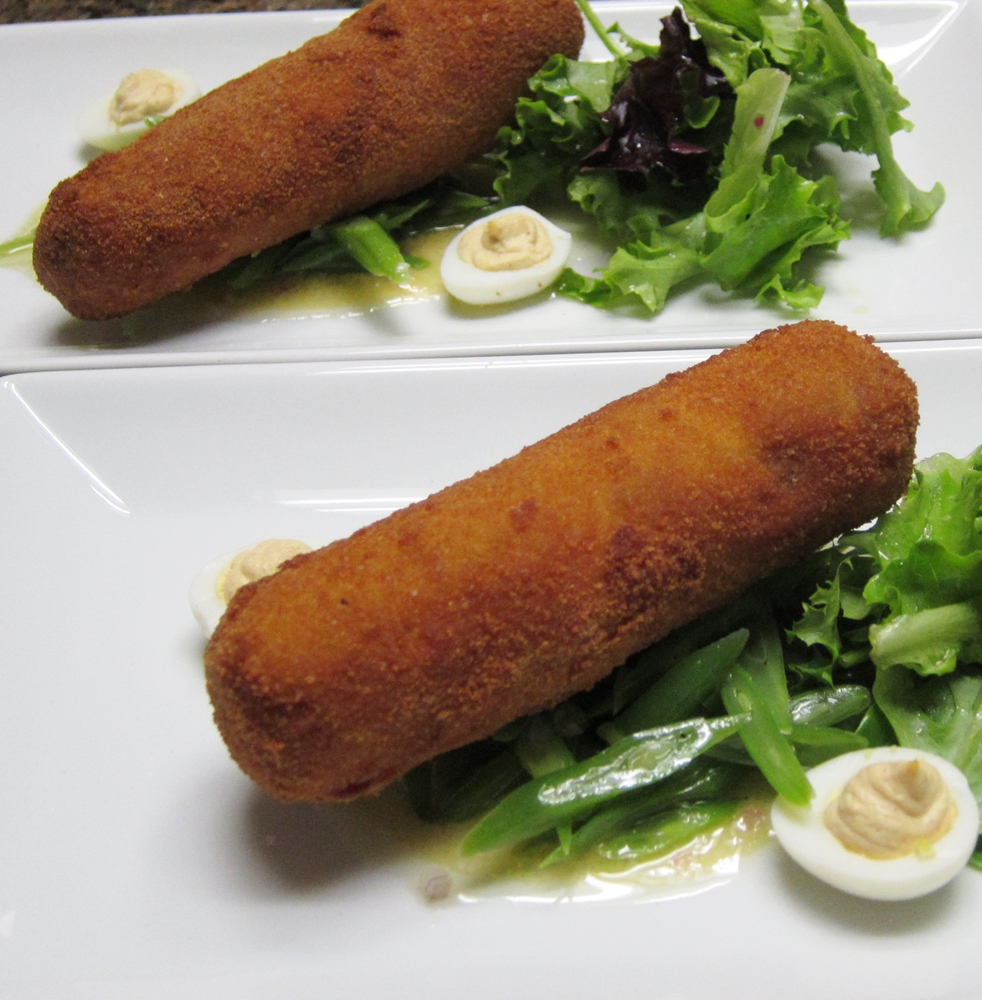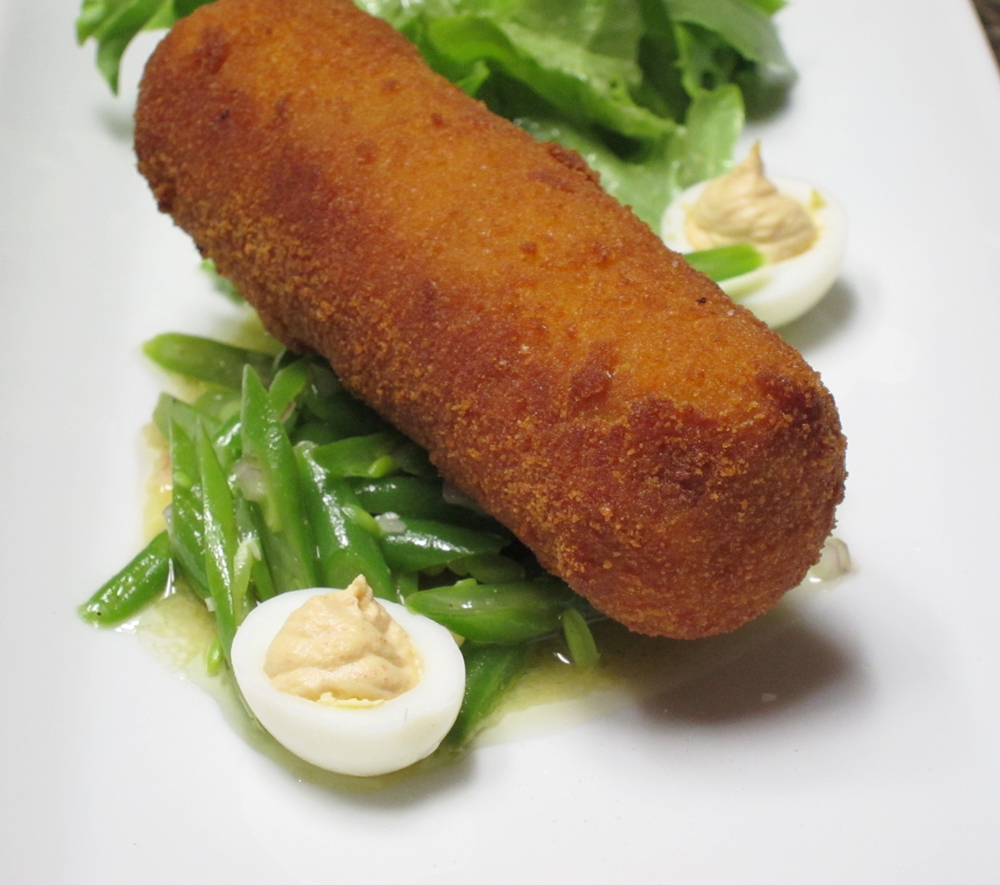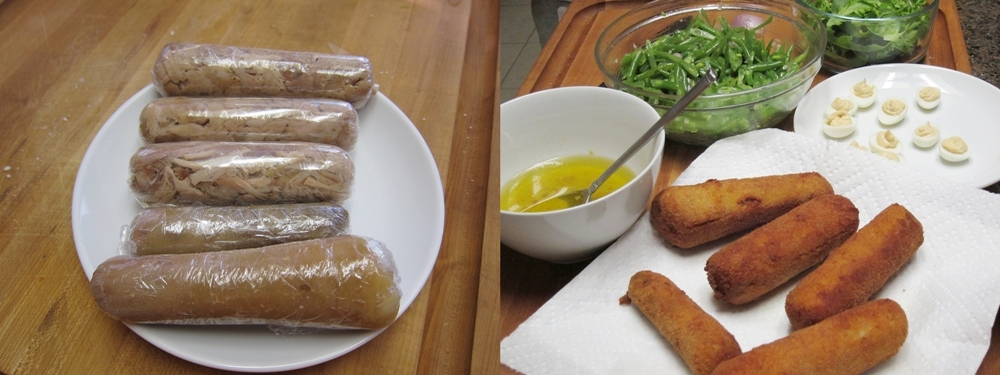Making something delicious out of “scraps” is one of the pleasures of cooking. It’s simple to make a piece of steak or a chop appetizing, but transforming an admittedly ugly-looking piece of pig – a tail in this case- into a dish worthy of a classy fine dining restaurant needs technique and some creativity. So, when a friend of mine gave me a couple of tails from two fat farm raised pigs, I turned to Thomas Keller for guidance. The tails can be just boiled and fried and they will be good, but I knew no one else in my household would eat them. I needed to transform those tails to a very appetizing and fun dish. Keller’s recipe in Under Pressure does exactly that.
First I dealt with the tails. These were not just the tails, but also some meat and fat attached to them from the top of the pig’s back. So I knew I can have more than just two servings from the two tails by using some of that meat. Raw, the tails and their attached meat/skin/fat looked like small sting rays. The tails were bagged in FoodSaver bags with a mixture of chicken stock, herbs, white wine, onions and carrots. I cooked them at 85C (185 F) for about 10 hours. At the end of the cooking time, the tails were very tender (both meat and skin). The tails can be cooked in a pot with a larger amount of liquid of course. However, cooking the tails sous vide at a perfectly controlled temperature guarantees that while the meat and skin gets thoroughly cooked, the skin does not rip or crack. This is very important for the next step. Additionally you do not get too much flavor loss to the surrounding liquid because in the bags the tails are surrounded by a relatively small amount of liquid and lots of aromatics.
While the pig tails are still very warm, they need to be deboned. It is much easier than it sounds and so worth it because, picking at tiny tail bones in a plated dish like this is not a fun experience. Besides, my little touch to the Keller dish, this way we can stuff the tails! I used a very sharp paring knife and slit the tails lengthwise. I then opened them like a book and removed the bones in one piece. It was very easy and the skin remained intact. The idea is to then season and reform the tails, now boneless, into neat rolls. The concentrated cooking liquid from the bags can be used to moisten them and, due to its high collagen content, set them into perfect cylinders. Before doing all that, I shredded the meat from the extra tail “attachments” and chopped some of the skin very finely. That meat is juicy and collagen rich already, but I also moistened it with a little cooking liquid from the bags. I used some of that mixture to stuff into the boneless tails before tightly wrapping them with plastic wrap into rolls. With the rest of the meat mixture I made faux-tails. I just formed three rough cylinders and then used plastic wrap to make a tight neat roll with each of them giving me a total of five “tails” for dinner. After thoroughly chilling those rolls they were completely solidified and ready to fry up. Frying the tails is pretty straight forward. They get the classic flour, egg wash, fine panko crumbs treatment. Twice. Then they are fried till golden and crispy.
The rest of the dish is simple. For the eggs I boiled the quail eggs and mixed the yolks with creme fraiche, paprika and salt. The filling was then supposed to be piped back into the whites using a small bag with a start tip. unfortunately, the star tip that I have is too big for the little quail eggs. So I sacrificed a bit of the aesthetic and used a small plastic ziplock bag with no decorating tip. The eggs were delicious and I had to save 4 of them for the plating before my 4-year old stole and ate them all. At one bite each, he could’ve finished off a whole dozen. Keller specifies the flat Romano beans for this dish. I can never find those. So I used regular green beans. I blanched them and sliced them very thinly on a bias. The beans get tossed with a shallot vinaigrette. I also needed a little frisee for plating but did not find any at my local store and did not have the time to go shopping for it. I used some spring greens instead. These were tossed with a simple vinaigrette as well.

Last but not least, I made a ravigote sauce. It’s made with Dijon mustard, olive oil, white wine vinegar, shallots, salt and pepper. Everyone loved this dish. Granted, the kids ate mostly the “faux tails” but my 7-year old, seemed to get a kick out of knowing that he was eating pig tails. It sure made me proud. It really worked out very well and looked great. The delicious rich, unctuous and very porky meat went perfectly with the tart flavors of the sauce. The skin was very tender and contrasted great with the meat inside and the crispy panko crumb shell encasing it. The beans added more sharp tastes and a great vegetable crunch. The eggs acted more of a tasty garnish and I ate mine before the rest fo the components.





Your posts just amaze me. I once tried Keller’s stuffed trotters from the French Laundry book, but I could never get the damn things boned without destroying the skin, maybe your method would work for that recipe as well. In any case, what an imaginative and tasty looking dinner you have produced.
I do think that getting the trotters properly de-boned and stuffed is trickier than the tails. They have numerous little tiny bones as opposed to the one series of bones in the tail. Cooking sous vide will be very helpful though with maintaining shape and integrity. I will post about it if I do try the FL recipe.
Good post. I learn something more difficult on completely different blogs everyday. It is going to at all times be stimulating to read content from other writers and observe somewhat something from their store. I’d prefer to make use of some with the content material on my weblog whether you don’t mind. Natually I’ll give you a hyperlink on your web blog. Thanks for sharing.
Nice post. Made Keller’s tails over the weekend and looks like we had similar experiences. Noticed that the tails that I had were quite a bit heavier than his (average of 220g vs 125g for Keller) and they included that fatty chunk from the the back like yours (which we picked out when eating – your method no doubt results in a more elegant and edible product). Also happy to see that my sauce looked a lot like yours. The sauce pictured in Keller’s book does not in fact match the recipe – looks more like a Bernaise. Hate when they do that!
BTW, I’ve made trotters in the sous vide before and they worked fabulously. One minus is the skin will rip, so simply score the trotter in advance and you should be fine. I’m also giving up feet for hocks. Feet have about a thimble full of meat in total and not worth the trouble IMHO, whereas hocks are chock full of tasty meaty morsels.
Hey John, thanks for stopping by my blog. I totally agree with you about hocks Vs. trotters. Interestingly enough the “trotter” recipe (Pied de Cochon) that Keller has in his Bouchon book uses hocks as well for that same reason. I’ve made it a while back and it is very nice. As for the sauce, I am not sure, the one in the book could be maybe better emulsified or something.
I want to make this recipe as well and was a bit sceptic about the ravigote sauce. The recipe says: 26 gr mustard/10 gr shallots/30 gr champagne vinegar/5 gr caster sugar/5 gr kosher salt/90 gr olive oil/90 gr canola oil. Won’t this give a way too oily and too thin sauce? What would you recommend? Thanks in advance!
It’s been a while but I remember I liked the sauce the way it is. It is on the thin side for sure.
Regarding the sauce, for next-day leftovers I took an egg yolk and beat the ravigote slowly into it. Thanks to the lecithin in the yolk it emulsified beautifully while making the sauce a bit more yellow as well. Then I added chives (as in the picture in the book). Much better sauce in my opinion!